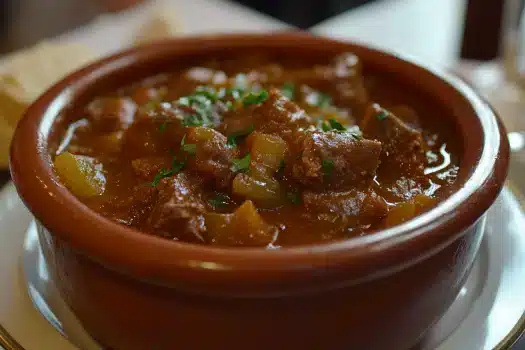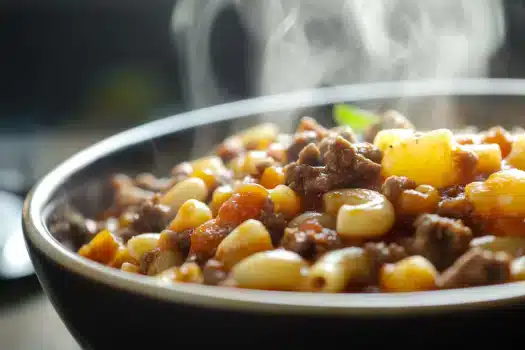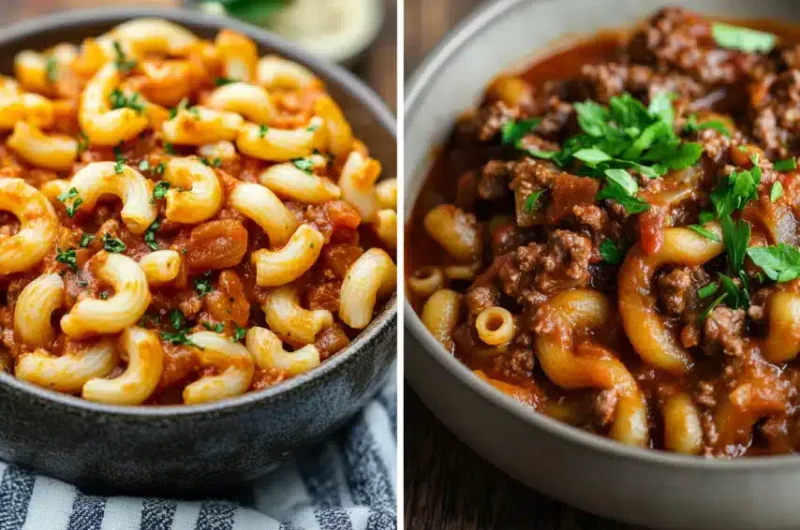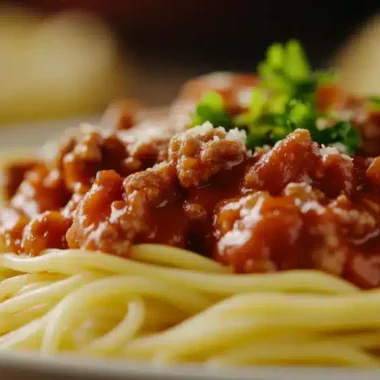Are you confused about whether beefaroni is the same as goulash? This article will explore these two popular dishes and uncover their key differences and similarities. From their distinct origins and ingredients to their preparation methods, we’ll provide a detailed comparison to help you understand what sets them apart. Let’s dive deep into the world of pasta dishes and meat stew to see just how much these meals have in common or differ.
Defining Beefaroni and Goulash: A Quick Overview
What Exactly is Beefaroni?
Beefaroni, at its core, is a simple pasta dish that comprises elbow macaroni, ground beef, and a tomato-based sauce. Companies often sell it as a canned food, emphasizing its convenience and ease of preparation. The ingredients are straightforward, and people know it for its familiar, slightly sweet flavor. People typically enjoy it as a quick meal because of its simplicity, especially as an easy meal.
What Exactly is Goulash?
Goulash, on the other hand, is a meat stew with deep roots in Hungarian cuisine. People characterize it by slowly stewing meat, such as beef or veal, combined with vegetables, a rich broth, and key spices, notably paprika. Unlike beefaroni, people often prepare goulash from scratch and cook it for an extended time. This results in complex and rich flavors, making it a hearty and substantial meal.
Tracing the Origins: Where Do These Dishes Come From?
The American Roots of Beefaroni
Beefaroni is an American invention. It emerged as a convenience food, designed for quick, easy, and shelf-stable preparation. Designers made the meal accessible and affordable for families that wanted a simple dinner. This history has deeply influenced beefaroni’s position in American cuisine, where it has become synonymous with simple weeknight meals and childhood nostalgia.
The Hungarian History of Goulash
Goulash, on the other hand, carries centuries of tradition from Hungarian cuisine. It evolved as a method of using tougher cuts of meat, simmering them for hours alongside root vegetables. The use of paprika is also a key element, reflecting Hungary’s national spice. Goulash is not just food; it’s a part of Hungarian culture, reflecting history and heritage, and its variations reflect diverse regional styles and preferences.
Key Ingredients Compared: What’s in Each Dish?
Beefaroni: Core Components and Additives
Beefaroni commonly uses elbow macaroni for its pasta. It uses ground beef, which is browned before being mixed into a tomato-based sauce. The tomato sauce is made with tomato paste or puree, water, and some seasonings. It also contains additives and preservatives to increase its shelf-stable life. Beefaroni prioritizes ease and convenience of its ingredients and method.
Goulash: Traditional Ingredients and Regional Variations
Traditional goulash typically uses tougher cuts of stewed meat, like beef or veal, and people cut it into cubes. Vegetables, such as onions, carrots, and bell peppers, contribute to the stew’s texture and flavor. People also add key seasonings, particularly paprika, as well as caraway seeds, or other herbs. Some variations may also include potatoes or other root vegetables. These varied ingredients add to the complexity of goulash, and cooks often let it cook to allow all the flavors to blend over time.
Preparation Methods: How Are They Made?
Making Beefaroni: A Quick and Easy Approach
Making beefaroni is a fast and straightforward process. You only need to heat up the canned version. When making it from scratch, you brown ground beef, add tomato sauce, and simmer the mixture along with some elbow macaroni until you cook the pasta through. People emphasize convenience and speed, making it an ideal meal for busy schedules.es.
Making Goulash: A Slow and Deliberate Process
Goulash, on the other hand, has a very different preparation. People slowly cook the stewed meat in a pot, often with onions and other vegetables. They add paprika and other spices early to allow their flavors to fully develop. They usually simmer goulash for an extended period, which allows the flavors to meld together, resulting in a rich and savory meat stew.
Flavor Profiles: Similarities and Differences

Beefaroni: The Familiar Taste of Convenience
Beefaroni has a flavor profile that emphasizes simplicity, and it is considered a comfort food. The tomato-based sauce is often slightly sweet, and the ground beef is mild with little added seasonings. The main taste is a combination of tomato and cooked pasta, it is more of a basic taste that is familiar for many people. The overall taste is designed to be appealing and quickly prepared.
Goulash: Rich and Complex Flavors
Goulash, by contrast, offers a much more complex flavor profile. The use of paprika and other spices, combined with the slow-cooked meat, provides a deep, savory, and nuanced flavor. The extended cooking process allows the ingredients to meld together, creating a rich and satisfying experience. The overall taste is a savory meal with a slightly spicy, earthy flavor.
Beefaroni vs. Goulash: A Side-by-Side Comparison
Similarities: What They Have in Common
While beefaroni and goulash are quite different, they do share some common elements. Both use meat, a tomato-based sauce, and can be considered comfort food. Both are popular and can be found in family dinner settings. They both offer a hearty, filling meal, with both having some element of protein and carbohydrates.
Differences: What Sets Them Apart
However, the differences between beefaroni and goulash are very significant. Their origins and cultural context are completely different. The ingredients and seasonings are quite distinct. The cooking methods and times contrast greatly, with beefaroni being a quick meal and goulash being a slow-cooked meal. Ultimately, these lead to quite different flavor profiles and overall eating experiences. (link out to: History of Pasta Dishes)
Serving and Enjoyment: How Are They Typically Eaten?

Serving Suggestions for Beefaroni
People typically enjoy beefaroni as a quick and simple meal, serving it directly from the can or a homemade dish. They often eat it as a stand-alone meal. You can serve side dishes, such as salads or simple vegetables, to add nutritional balance. This becomes a go-to meal for those who need something quick and easy.ple vegetables, can be served to add nutritional balance. This is a go-to meal for when you need something quick and easy.
Serving Suggestions for Goulash
People traditionally serve goulash in bowls as a hearty stew, often with a side of bread for dipping and soaking up the broth. They can serve it with a dollop of sour cream or a side of potatoes. People intend it to be savored as a substantial and satisfying meal. It is a perfect meal for colder weather and special occasions.
Can Beefaroni and Goulash Be Confused? Addressing Common Misconceptions
The Confusion Between Pasta and Stews
The main reasons why some people might confuse beefaroni and goulash are the shared elements of meat and a tomato-based sauce. However, this is very general and common in a lot of different meals. Cultural influences and lack of awareness can add to the confusion. The presence of meat and a tomato-based sauce might cause an incorrect assumption that both are the same type of dish.
Clear Distinctions: Why They Are Not the Same
However, the key points that clearly distinguish beefaroni from goulash are their origins, ingredients, and cooking methods. Beefaroni is an American cuisine pasta dish with quick preparation, while goulash is a Hungarian cuisine meat stew requiring a slow-cooking process. Knowing the origins can make these distinctions easy to comprehend. The differences in cooking processes makes them very distinct meals.
Homemade Versions: Bridging the Gap
Making Homemade Beefaroni: Adding Depth and Flavor
Making homemade beefaroni is a great way to enhance its basic flavor profile by using fresh ingredients, such as homemade tomato sauce, and a variety of spices. You can also use higher-quality ground beef, different types of pasta, and add extra vegetables for added nutrition and flavor. This will add depth and complexity to the original, convenient meal.
Making Homemade Goulash: Embracing Authenticity
To embrace goulash’s authenticity, you can follow traditional Hungarian cuisine recipes. This includes slow-cooking meat until it’s very tender, using authentic spices and fresh ingredients. Adding vegetables and cooking with care allows you to create a dish with very complex and authentic flavors. This will allow you to experience the dish in a very traditional way.
Making Homemade Beefaroni and Goulash: Step-by-Step and Nutritional Insights
Crafting Homemade Beefaroni: A Simple Approach
To truly appreciate the differences between beefaroni and goulash, let’s explore the process of making each from scratch, along with their approximate nutritional content. First, for a homemade beefaroni, you’ll begin by browning approximately 200 grams of lean ground beef in a large skillet, breaking it into small crumbles as it cooks, and draining off any excess fat, of course, to keep it healthier. Then, you’ll add about 400 grams of your favorite tomato sauce, or a mix of tomato paste and water, which contributes to the classic beefaroni taste; however, you have the liberty of adding your preferred seasonings, such as a teaspoon each of onion powder, garlic powder, and paprika, for a flavor that rivals the canned version; also, a dash of sugar and a pinch of salt can also enhance it.
Preparing Authentic Goulash: A Deliberate Process
On the other hand, goulash demands a more deliberate approach. To start, in a large pot or Dutch oven, you will sear about 200 grams of cubed beef chuck in a bit of oil until brown on all sides, after which, you’ll remove the meat and set aside. Next, you’ll add some chopped onions, usually about 100 grams, and cook until softened; furthermore, you’ll stir in approximately two tablespoons of high-quality paprika, along with a teaspoon of caraway seeds, half a teaspoon of garlic powder, and salt, allowing the spices to bloom for a minute or two, enhancing the flavor; then, return the beef to the pot; afterward, you can pour in about 400ml of beef broth to cover the meat, along with diced bell peppers around 100 grams.
Nutritional Content: A Side-by-Side Glance
Subsequently, this mixture should simmer gently on the stove for about 10 minutes, allowing all the flavors to meld together before the addition of around 200 grams of elbow macaroni, cooked separately according to package directions until al dente; as soon as the pasta is ready, you will stir it into the sauce until fully coated; now, your homemade beefaroni is ready to serve, offering a fresher taste than its canned counterpart. The goulash should simmer gently for at least two hours, or even longer, until the meat becomes very tender; at last, you will taste and adjust your seasonings; finally, you’ll serve it hot, often with a side of bread or potatoes. Regarding nutritional content, per 100g, homemade beefaroni typically has around 150-180 calories, 6-8g of fat, 15-20g of carbohydrates, and 7-9g of protein; conversely, goulash, per 100g, usually contains 120-150 calories, 5-7g of fat, 8-10g of carbohydrates, and 9-12g of protein, but these values can vary based on the specific ingredients and portion sizes.
FAQs About Beefaroni and Goulash: Addressing Your Questions
10.1. Is beefaroni a type of goulash?
No, beefaroni is not a type of goulash. They are very different dishes with different origins, ingredients, and cooking methods.
10.2. What is the main difference between beefaroni and goulash?
The main difference lies in their preparation and cultural origins. Beefaroni is a quick American cuisine pasta dish, while goulash is a slow-cooked Hungarian cuisine meat stew.
10.3. Does goulash contain pasta like beefaroni?
No, goulash typically does not contain pasta. It’s primarily a meat stew with vegetables in a broth or sauce.
10.4. What are the key spices in goulash?
The key spice in goulash is paprika, which is used generously. Other spices include caraway seeds, garlic, and other herbs.
10.5. Is goulash always slow-cooked?
Yes, people traditionally slow-cook goulash, which is essential for developing its rich and complex flavors and tenderizing the meat.ex flavors and tenderizing the meat.
10.6. Is beefaroni a comfort food like goulash?
Yes, both beefaroni and goulash are often considered comfort food, however they have very different cultural contexts.
10.7. Can I make vegetarian versions of beefaroni and goulash?
Yes, you can make vegetarian versions of both by substituting the meat with plant-based alternatives or a mix of vegetables.
10.8. What are traditional side dishes for goulash?
Traditional side dishes for goulash include bread, sour cream, or potatoes.
Conclusion
So, is beefaroni the same as goulash? The answer is a clear no. While one can consider both hearty meals, and both may use meat and a tomato-based sauce, their origins, ingredients, cooking methods, and flavor profiles differ vastly. Beefaroni, with its American cuisine convenience, and goulash, with its rich Hungarian cuisine heritage, each have their own unique place in the world of comfort food. When you understand these distinctions, you enhance your appreciation for both dishes.






